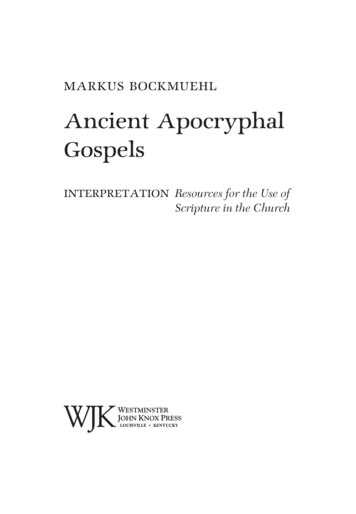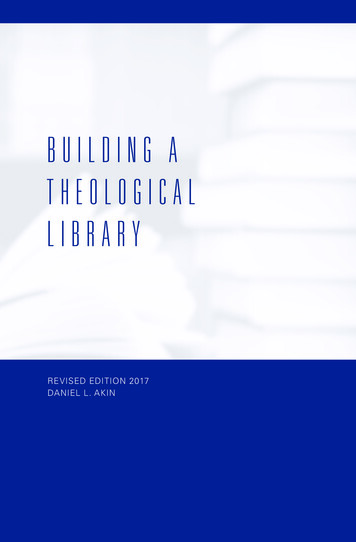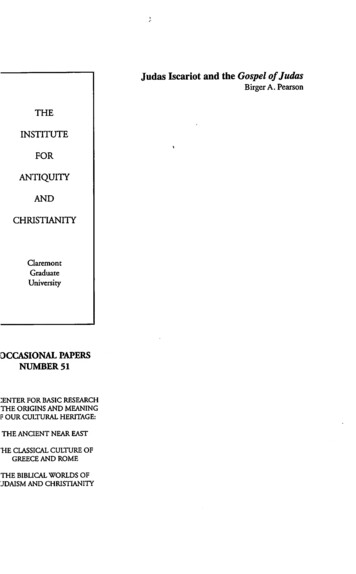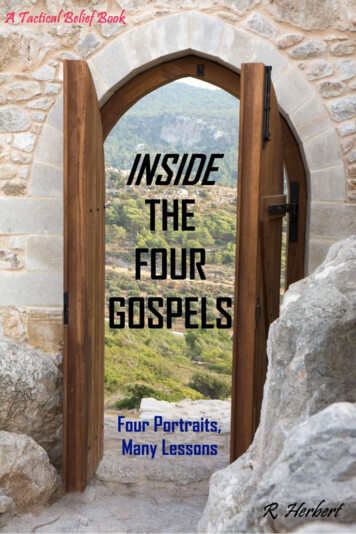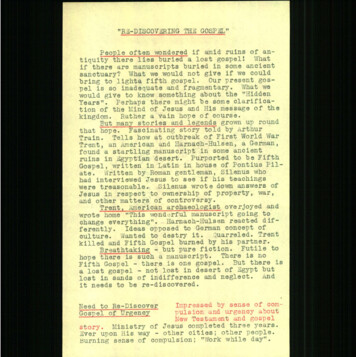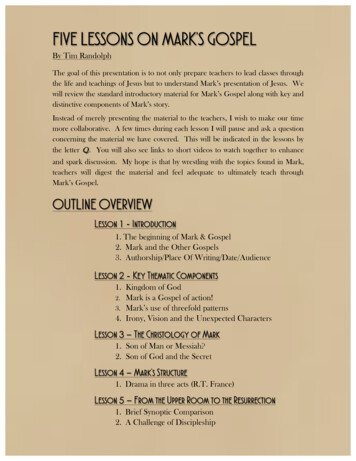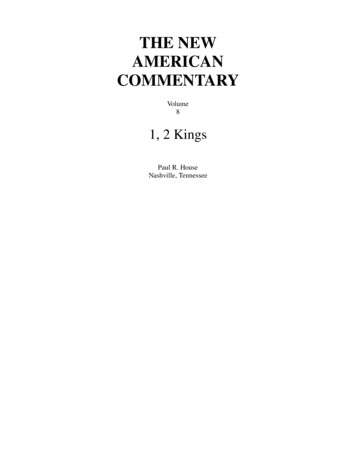
Transcription
THE NEWAMERICANCOMMENTARYVolume81, 2 KingsPaul R. HouseNashville, Tennessee
General EditorE. RAY CLENDENENAssociate General Editor, OT Associate General Editor, NTKENNETH A. MATHEWSDAVID S. DOCKERYConsulting EditorsOld TestamentNew TestamentL. RUSS BUSHRICHARD R. MELICK, JR.DUANE A. GARRETT PAIGE PATTERSONLARRY L. WALKER CURTIS A. VAUGHANManuscript EditorsLINDA L. SCOTTMARC A. JOLLEY 1995 Broadman & Holman PublishersAll rights reserved4201-8ISBN 0-8054-0108-3Dewey Decimal Classification:222.5Subject Heading:BIBLE.O.T.KINGSLibrary of Congress Catalog Card Number:94-47508Unless otherwise indicated, Scripture quotations are from the Holy Bible, New International Version(NIV), copyright 1973, 1978, 1984 by International Bible Society. Used by permission of ZondervanBible Publishers. Quotations marked NEB are from The New English Bible. Copyright TheDelegates of the Oxford University Press and the Syndics of the Cambridge University Press, 1961,1970. Used by permission. Scripture quotations marked GNB are from the Good News Bible, the Biblein Today’s English Version. Old Testament: Copyright American Bible Society 1976; NewTestament: Copyright American Bible Society 1966, 1971, 1976. Used by permission. Quotationsmarked NRSV are from the New Revised Standard Version of the Bible, copyright 1989 by theDivision of Christian Education of the National Council of Churches of Christ in the United States ofAmerica. Used by permission. All rights reserved. Quotations marked NASB are from the NewAmerican Standard Bible. The Lockman Foundation, 1960, 1962, 1963, 1968, 1971, 1972, 1973,1975, 1977. Used by permission.Library of Congress Cataloging-in-Publication DataHouse, Paul R., 19581, 2 Kings / Paul R. House.p.cm. - (The New American commentary ; vol. 8)Includes bibliographical references and indexes.ISBN 0-8054-0108-3 (hardcover)1. Bible. O.T. Kings-Commentaries. I. Title. II. Title: First, second Kings. III. Series: The NewAmerican commentary ; v. 8.BS1335.3.H681995222 .5077-dc20
To Jim Dixon, Drew Hayes, Tim McCoy, and Mike TuckerOld Friends, Reading Pastors, Men of GodEditors’ PrefaceGod’s Word does not change. God’s world, however, changes in every generation. These changes, inaddition to new findings by scholars and a new variety of challenges to the gospel message, call for thechurch in each generation to interpret and apply God’s Word for God’s people. Thus, THE NEWAMERICAN COMMENTARY is introduced to bridge the twentieth and twenty-first centuries. Thisnew series has been designed primarily to enable pastors, teachers, and students to read the Bible withclarity and proclaim it with power.In one sense THE NEW AMERICAN COMMENTARY is not new, for it represents thecontinuation of a heritage rich in biblical and theological exposition. The title of this forty-volume setpoints to the continuity of this series with an important commentary project published at the end of thenineteenth century called AN AMERICAN COMMENTARY, edited by Alvah Hovey. The older seriesincluded, among other significant contributions, the outstanding volume on Matthew by John A.Broadus, from whom the publisher of the new series, Broadman Press, partly derives its name. Theformer series was authored and edited by scholars committed to the infallibility of Scripture, making ita solid foundation for the present project. In line with this heritage, all NAC authors affirm the divineinspiration, inerrancy, complete truthfulness, and full authority of the Bible. The perspective of theNAC is unapologetically confessional and rooted in the evangelical tradition.Since a commentary is a fundamental tool for the expositor or teacher who seeks to interpret andapply Scripture in the church or classroom, the NAC focuses on communicating the theologicalstructure and content of each biblical book. The writers seek to illuminate both the historical meaningand contemporary significance of Holy Scripture.In its attempt to make a unique contribution to the Christian community, the NAC focuses on twoconcerns. First, the commentary emphasizes how each section of a book fits together so that the readerbecomes aware of the theological unity of each book and of Scripture as a whole. The writers, however,remain aware of the Bible’s inherently rich variety. Second, the NAC is produced with the convictionthat the Bible primarily belongs to the church. We believe that scholarship and the academy provide anindispensable foundation for biblical understanding and the service of Christ, but the editors andauthors of this series have attempted to communicate the findings of their research in a manner that willbuild up the whole body of Christ. Thus, the commentary concentrates on theological exegesis, whileproviding practical, applicable exposition.THE NEW AMERICAN COMMENTARY’s theological focus enables the reader to see the parts aswell as the whole of Scripture. The biblical books vary in content, context, literary type, and style. Inaddition to this rich variety, the editors and authors recognize that the doctrinal emphasis and use of thebiblical books differs in various places, contexts, and cultures among God’s people. These factors, aswell as other concerns, have led the editors to give freedom to the writers to wrestle with the issuesraised by the scholarly community surrounding each book and to determine the appropriate shape andlength of the introductory materials. Moreover, each writer has developed the structure of thecommentary in a way best suited for expounding the basic structure and the meaning of the biblicalbooks for our day. Generally, discussions relating to contemporary scholarship and technical points of
grammar and syntax appear in the footnotes and not in the text of the commentary. This format allowspastors and interested laypersons, scholars and teachers, and serious college and seminary students toprofit from the commentary at various levels. This approach has been employed because we believethat all Christians have the privilege and responsibility to read and seek to understand the Bible forthemselves.Consistent with the desire to produce a readable, up-to-date commentary, the editors selected theNew International Version as the standard translation for the commentary series. The selection wasmade primarily because of the NIV’s faithfulness to the original languages and its beautiful andreadable style. The authors, however, have been given the liberty to differ at places from the NIV asthey develop their own translations from the Greek and Hebrew texts.The NAC reflects the vision and leadership of those who provide oversight for Broadman Press,who in 1987 called for a new commentary series that would evidence a commitment to the inerrancy ofScripture and a faithfulness to the classic Christian tradition. While the commentary adopts an“American” name, it should be noted some writers represent countries outside the United States, givingthe commentary an international perspective. The diverse group of writers includes scholars, teachers,and administrators from almost twenty different colleges and seminaries, as well as pastors,missionaries, and a layperson.The editors and writers hope that THE NEW AMERICAN COMMENTARY will be helpful andinstructive for pastors and teachers, scholars and students, for men and women in the churches whostudy and teach God’s Word in various settings. We trust that for editors, authors, and readers alike, thecommentary will be used to build up the church, encourage obedience, and bring renewal to God’speople. Above all, we pray that the NAC will bring glory and honor to our Lord, who has graciouslyredeemed us and faithfully revealed himself to us in his Holy Word.SOLI DEO GLORIAThe EditorsAcknowledgmentsSeveral people deserve thanks for their help in this project. My family has always supported mywriting projects, and this time was no exception. Becky, my wife, and Molly, my daughter, exhorted meto work hard and finish on time. Both were a source of joy and inspiration. They are infinitely worthwhatever commitments I have made to them. Roy House, my father, offered some solid suggestionsand read a large portion of the manuscript. His support has been lifelong, at least so far.My colleagues at Taylor University were also quite helpful. Each member of the departments ofBiblical Studies, Christian Education, and Philosophy extended real and needed encouragement. JoanneGiger typed the manuscript with great efficiency and offered sage commentary on the commentary.Taylor University’s administration, led by Daryl Yost, Bob Pitts, and Dwight Jessup, allowed me acourse reduction during the semester the manuscript was due. I work with good people, a fact Iappreciate and hope never to take for granted.The editors at Broadman & Holman were kind as well. Ray Clendenen, Marc Jolley, and TrentButler were all very strategic counselors, and Ray and Marc, as well as Linda Scott, saw the manuscriptthrough to completion with patience and grace. Indeed they made the volume a better book than itwould have been. These and other persons at Broadman & Holman made this project a good experience
for me.Certain friends must also be thanked. Scott Hafemann, Jim Dixon, Carol Mott, Gordon Kingsley,and Suzanne House Kingsley kept me going when I wanted to stop writing, among other things. Theirgoodness to me mediated God’s presence, which is the highest compliment I know how to give.The volume is dedicated to four special friends, each of whom is supposed to be a member of the“reading pastor” target group this series tries to address. I met these men at Southern Seminary in the1980s, where we stuck together during difficult days. I have enjoyed ministering with them from timeto time over the past decade. They were then and are now good people and good ministers, goodconversationalists and good listeners, good Christians and good companions.For these and other kindnesses I am extremely grateful.Paul R. HouseTaylor UniversityUpland, IndianaAuthor’s PrefaceFew biblical books are as neglected by the church as 1, 2 Kings. There are several reasons for thissituation. First, some preachers find it difficult to construct sermons from Old Testament texts. Second,misconceptions about Old Testament history, such as its supposedly boring, nontheological nature,cause laypersons to question the books’ value for devotional reading. Third, Christians from all walksof life doubt the practicality of studying events that occurred three thousand years ago. Fourth, evendiligent Bible students may get discouraged trying to fit the kings, foreign enemies, and relevant datesinto a coherent whole. Fifth, commentaries on 1, 2 Kings often explain chronological andcompositional matters without exploring the books’ theological and literary richness.These barriers can be overcome. Pastors can learn to prepare doctrinally sound, relevant messagesfrom 1, 2 Kings. How? By developing the ability to read the books’ stories1 as mirrors of today’sworld. Historical situations such as war, poverty, political corruption, and oppression are permanentsymptoms of the human condition. Likewise faithfulness, loyalty, and obedience remain marks ofGod’s people. Also, crucial Bible doctrines like God’s sovereignty, redemption, wrath, and lovepermeate 1, 2 Kings. Creative, insightful communicators will quickly grasp the many ways these bookscan enrich their hearers’ lives.Once pastors proclaim the books’ value, laypersons will begin to read 1, 2 Kings with renewedinterest and enthusiasm. Characters from Israel’s history will become instructors, even companions,rather than obscure, forbidding figures from the past. Guidance for life will emerge as these books areunderstood to contain real life stories written for people involved in real life.Scholars also can help by approaching 1, 2 Kings in a more holistic fashion. Background issuessuch as chronology, composition, ancient history, and textual criticism are, and will always be,important for interpreting 1, 2 Kings. Yet they need to become parts of an integrated approach to thebooks, an approach that uses background material to inform, not replace, literary and theologicalanalysis. Similarly, expositors must make their interpretations of texts consistent with historical facts.Sloppy, unfounded applications are as inexcusable as dry, grindingly boring presentations of historicaldata.2Obviously, these lofty goals for scholars, pastors, and laypersons will not be met by accident. Thus,
this commentary will follow a format designed to integrate the major elements of thorough “theologicalexegesis.”3 These elements include historical, literary, canonical, theological, and applicationalconcerns.4 Each of these categories is important for a scholarly and useful study of 1, 2 Kings, andeach will be stressed in the introduction and analysis of the books, so it is appropriate to outline themnow.Historical DetailsIt is impossible to interpret 1, 2 Kings properly without some knowledge of its historical context.The very nature of the literature dictates this conviction. Kings made decisions based on historical,social, and political realities. Nations reacted to one another for the same reasons. Prophets andprophecy arose within specific cultural contexts. What happened before and after the event in questionoften determined that event’s significance.Obviously, a work like 1, 2 Kings that covers roughly four hundred years of history cannot possiblyinclude every occurrence within its time frame. The author had to select what events would receiveattention. Thus, it is vital to theorize about the author’s era, situation, and theology. These details mayexplain why the history has been shaped into its current form. Like all authors, historians seekobjectivity yet remain, at least partially, products of their own times. They write in part, then, to fit theperspectives and needs of those times.Skilled interpreters soon learn the value of historical research. Indeed, they find that discoveringwhat a passage meant to its original audience is the first step to its application to present-daycongregations. Accurate historical knowledge guards against fanciful or heretical readings of texts, for,as Stuart and Fee cogently conclude, “a text cannot mean what it never meant.”5 Knowing how apassage affected ancient readers leads to uncovering ways the text can impact readers now.Literary DetailsLiterary analysis of the Old Testament has become quite prominent during the past quartercentury.6 This development should aid the interpretation of 1, 2 Kings in a number of ways. First,literary criticism focuses on how causes and effects in stories create plots. Certainly 1, 2 Kings presentIsrael’s history as a series of events that describe how and why the nation fell from the heights ofnational prosperity to the depths of conquest and exile. Second, literary criticism stressescharacterization, or how authors present characters. Solomon, Jeroboam, Elijah, Elisha, Jezebel, andothers are well-developed, compelling individuals. They require, indeed they deserve, careful analysis.Third, literary studies uncover important themes. These themes unite characters and plot and alsoprovide structural links between major narrative sections. In biblical texts themes often divulgetheological emphases. First and Second Kings emphasize certain ideas repeatedly, all of which indicatethe author’s theological perspective on Israel’s history. Fourth, literary criticism explores a story’snarrative viewpoint or what commentary a book offers on the events it describes. At several key pointsin the story, the author of 1, 2 Kings explains the significance of important events. Such editorialcomments do offer hints about the books’ composition, but they also give information regarding plotand theme.There is no need to pit historical studies and literary analysis against each other when analyzing 1, 2Kings. Rather, each can inform the other. Characters, themes, and commentary tell Israel’s story.Historical data gives this story content and context. How the author combines these components
determines the books’ literary, historical, theological, and pedagogical effectiveness.Canonical DetailsFirst and Second Kings are considered sacred within both Judaism and Christianity. In the HebrewBible they are part of what is called the former prophets, which includes Joshua, Judges, 1, 2 Samuel,and 1, 2 Kings. Clearly, in this scheme they conclude the history of Israel that begins with the conquestof the promised land. Thus, they comment on previous books and provide information that subsequentbooks may discuss. Of course, Christians add the New Testament to their list of inspired books, whichmeans that twenty-seven more books may reflect on the events and teachings found in 1, 2 Kings.Given these facts, it is improper to interpret 1, 2 Kings only in isolation. Rather, they must beexamined with their canonical role in mind. Interpreters must note how they help explain other booksand how the rest of the Bible explains them. This type of analysis, called canonical criticism, is, likeliterary criticism, fairly new.7 Its proponents seek to interpret texts within their own historical context,but then to note how an individual passage’s theology relates to the rest of the Bible.8 In this way theBible is allowed to interpret itself whenever possible.Canonical analysis aids 1, 2 Kings studies in at least five ways. First, it helps demonstrate thesimilarities and differences in the accounts in 1, 2 Kings and 1, 2 Chronicles. Second, it shows how 1, 2Kings fits into the former prophets. Third, it suggests ways that the New Testament’s use of 1, 2 Kingsilluminates the books’ meaning. Fourth, it helps exegetes develop a biblical theology. Fifth, besidesthese benefits, it forwards the exegetical process begun by examining historical and literary details.Historical data explains information vital for understanding the original author and audience’s situation.It also discusses details readers need to know to read a text intelligently. In other words, it deals withpretextual matters. Literary data examines the text itself, for it deals with the text as it stands. Canonicalinterpretation, then, explains how later biblical audiences interpreted this historical, literary document.It thus deals with posttextual issues in a way that leads interpreters closer to an appropriate applicationof the text for current audiences.Theological DetailsTheology can be defined in a number of ways. For example, it is an academic discipline, a personalbelief system, or a school of thought all at the same time. At its most basic level, however, the wordmeans “a study of God.” Therefore, as an academic or exegetical exercise the term “seems to signify aspecial science, a very special science, whose task is ‘to apprehend, understand, and speak ofGod.’”9 Because of God’s obvious importance for theology, this concern impacts every other aspect ofinterpretation.10For example, understanding God’s nature helps explain the human race’s sinfulness and need forsalvation and God’s desire to redeem these sinners. Further, knowing that a merciful God attempted tomake and keep a covenant with Israel explains the Lord’s anger with that nation’s idolatry in 1, 2Kings. Finally, grasping the notion that God created the entire world and thus has dominion over itexplains why the Lord rules all nations and can direct their actions in 1, 2 Kings. Clearly, individuals,nations, and thus history are all impacted by a proper understanding of God.Theology also acts as a link between the ancient world and today because its emphasis on theeternal God gives it a timeless quality vital for applying texts to current situations. God remains holy,just, and merciful. Human beings continue to need salvation and discipline. Nations still need to obey
their Creator. Interpreters maintain their relevance and effectiveness only by examining their ownsituations in a manner similar to the author of 1, 2 Kings.In this way theological reflection continues the process from pretextual studies to application oftexts. It uses the material collected from historical analysis to understand the situation that spawned thetheological conclusions found in the Bible. It analyzes literary data to learn how themes, characters,plots, and settings portray sin, salvation, and God’s sovereignty. It utilizes the whole Bible’sinterpretation of individual passages to build a coherent pattern of thought. In short, theology gathersup the various exegetical strands and makes them available for application.This emphasis on theology is particularly important for reclaiming 1, 2 Kings as Scripture thechurch should heed. For too long these books have been viewed as arid historical documents. Whentheir theological value is recognized, though, this misunderstanding will be at least partially erased.Preaching will be enriched by theologically based application that will replace self-help based onindividual opinions. Every segment of the church will thereby benefit.Applicational DetailsOnly when historical, literary, canonical, and theological data have been gathered can an expositormake logical and valid application of a text. Also the applicational task then becomes much simpler.The expositor knows how the text emerged in history and what cultural factors impacted its initialcreation. The passage’s distinct means of presentation has been acknowledged, and intellectually andspiritually stimulating characters and situations have been identified. What the Bible itself says aboutthe text has been determined and the major doctrinal ideas gathered.With all this information at hand, the interpreter can compare the biblical situation to that of acurrent audience in order to determine a text’s significance. “Significance” means the way biblicalmaterial attempts to impact readers. Many types of significances appear in Scripture, but perhaps fourbasic ones will help at this point. First, a text’s significance may lie in its portrayal of a positive ornegative example. Solomon’s choice of wisdom over wealth or fame in 1 Kgs 3:4–15 is an example ofwise decision making. His fascination with idols in 1 Kgs 11:1–13, though, warns readers againsttaking similar actions themselves. Second, a passage’s significance may lie in the fact that it contains acommand. For instance, in 1 Kgs 18:40 Elijah commands the people to expel Baal worship (idolatry)from their midst.Third, a text’s significance may come from its description of an event. Elijah’s ascension to heavenin a chariot of fire indicates the prophet’s preeminence without stating that truth explicitly. Fourth, atext’s significance may be stated directly by the book’s narrator. For example, the author of 1, 2 Kingsconstantly evaluates kings and nations. Summary passages like 2 Kings 17 tell the reader whyimportant events occur so that no misconception can arise.When a text’s significance has been determined, expositors can then compare their findings to theneeds of their audience. They can then note how the original audience’s composition, age, situation,and character traits compare to their audience’s. For instance, if 1, 2 Kings addresses an audience thatwas prone to take God for granted, does the current audience have similar failings? If the ancientaudience needed to seek the Lord’s forgiveness after a long period of sinfulness, then that text couldspeak to a like situation in a current audience. More positively, if God approves of actions taken in 1, 2Kings, perhaps an expositor can encourage a contemporary group in the same way.Other suggestions will be made during the actual analysis of 1, 2 Kings. It must be noted, however,that commentaries can only mention possible applications of texts. They cannot do the expositors’ workfor them, since the commentator does not know the speakers’ audiences. It is the individualinterpreter’s responsibility, then, to gather and apply the data found in the commentary.
ConclusionThis commentary will seek to model the exegetical principles outlined above. Every text will notreceive exhaustive treatment, lest the volume become too long and unusable. Still, where new sectionsand situations occur, the historical situation will be noted. Major and minor characters will be analyzed,main plot elements highlighted, and vital themes exposed. At the end of appropriate sections will befound remarks on how the texts are understood by other passages and their theological significance.Possible applications then will be suggested briefly. Readers should be aware of this method in order togain maximum use of the studies whether reading the commentary from cover to cover or using it tostudy an individual passage.The New American Commentary seeks to meet the needs of many types of readers. But chief amongthese is the “reading pastor.” This designated audience assumes that pastors must be serious studentsand skilled communicators. If this commentary fulfills its purpose, it will provide the kind of researchscholarly pastors demand from a reference tool and also will address the exciting and demanding tasksof preaching and teaching. No book can meet the needs of every reader, but the methodology outlinedin this section is intended to help as many individuals as possible as they study this portion of God’sWord.AbbreviationsBible BooksGenExodLevNumDeutJoshJudgRuth1, 2 Sam1, 2 Kgs1, 2 nahMicNahHabZephHagLukeJohnActsRom1, 2 CorGalEphPhilCol1, 2 Thess1, 2 TimTitusPhlmHebJas
Ps (pl. Pss)ProvEcclSongZechMalMattMark1, 2 Pet1, 2, 3 JohnJudeRevApocryphaAdd EsthBarBel1, 2 Esdr4 EzraJdtEp Jer1, 2, 3, 4 MacPr AzarPr ManSirSusTobWisThe Additions to the Book of EstherBaruchBel and the Dragon1, 2 Esdras4 EzraJudithEpistle of Jeremiah1, 2, 3, 4 MaccabeesPrayer of Azariah and the Song of the Three JewsPrayer of ManassehSirach, EcclesiasticusSusannaTobitThe Wisdom of SolomonCommonly Used SourcesAASOR Annual of the American Schools of Oriental ResearchAB Anchor BibleABD Anchor Bible Dictionary, ed. D. N FreedmanABW Archaeology and the Biblical WorldAC An American Commentary, ed. A. HoveyAcOr Acta orientaliaAEL M. Lichtheim, Ancient Egyptian LiteratureAJSL American Journal of Semitic Languages and LiteratureAkk. AkkadianAnBibAnalecta BiblicaANET J. B. Pritchard, ed., Ancient Near Eastern TextsAOATAlter Orient und Altes TestamentAOTSArchaeology and Old Testament Study, ed. D. W. ThomasArOrArchiv orientální
ATD Das Alte Testament DeutschATRAnglican Theological ReviewAusBRAustralian Biblical ReviewBABiblical ArchaeologistBAGD W. Bauer, W. F. Arndt, F. W. Gingrich, and F. W. Danker, Greek-English Lexicon of theNew TestamentBALSBible and Literature SeriesBARevBiblical Archaeology ReviewBASORBulletin of the American Schools of Oriental ResearchBDBF. Brown, S. R. Driver, and C. A. Briggs, Hebrew and English Lexicon of the OldTestamentBETL Bibliotheca ephemeridum theologicarum lovaniensiumBFTBiblical Foundations in TheologyBHS Biblia hebraica stuttgartensiaBibBiblicaBKATBiblischer Kommentar: Altes TestamentBO Bibliotheca orientalisBSacBibliotheca SacraBSCBible Study CommentaryBT Bible TranslatorBurH Buried HistoryBZ Biblische ZeitschriftBZAW Beihefte zur ZAWCAD The Assyrian Dictionary of the Oriental Institute of the University of ChicagoCAH Cambridge Ancient HistoryCB Century BibleCBSCCambridge Bible for Schools and CollegesCBC Cambridge Bible CommentaryCBQ Catholic Biblical QuarterlyCC The Communicator’s CommentaryCCK Chronicles of Chaldean Kings, D. J. WisemanCHAL Concise Hebrew and Aramaic Lexicon, ed. W. L. HolladayCOT Commentary on the Old Testament, C. F. Keil and F. DelitzschCTRCriswell Theological ReviewDOTTDocuments from Old Testament Times, ed. D. W. ThomasEAEHL Encyclopedia of Archaeological Excavations in the Holy Land, ed. M. Avi-YonahDSS Dead Sea ScrollsEBC Expositor’s Bible CommentaryEbibEtudes bibliquesETL Ephermerides theologicae lovaniensesEvBCEveryman’s Bible CommentaryFBForschung zur BibelFOTL Forms of Old Testament LiteratureGKCGesenius’ Hebrew Grammar, ed. E. Kautzsch, trans. A. E. CowleyGTJGrace Theological JournalHARHebrew Annual ReviewHATHandbuch zum Alten TestamentHBT Horizons in Biblical TheologyHDRHarvard Dissertations in Religion
HerHermeneiaHKATHandkommentar zum Alten TestamentHSMHarvard Semitic MonographsHTHelps for TranslatorsHTRHarvard Theological ReviewHUCAHebrew Union College AnnualIBInterpreter’s BibleIBCInterpretation: A Bible Commentary for Teaching and PreachingICCInternational Critical CommentaryIDBInterpreter’s Dictionary of the Bible, ed. G. A. Buttrick, et al.IDBSupSupplementary volume to IDBIBHSB. K. Waltke and M. O’Connor, Introduction to Biblical Hebrew SyntaxIEJIsrael Exploration JournalIESIsrael Exploration SocietyIntInterpretationITCInternational Theological CommentaryIOS Israel Oriental SocietyISBEInternational Standard Bible Encyclopedia, rev. ed., G. W. BromileyIJT Indian Journal of TheologyITCInternational Theological CommentaryJANESJournal of Ancient Near Eastern SocietyJAOSJournal of the American Oriental SocietyJBL Journal of Biblical LiteratureJBRJournal of Bible and ReligionJCSJournal of Cuneiform StudiesJEAJournal of Egyptian ArchaeologyJETSJournal of the Evangelical Theological SocietyJJSJournal of Jewish StudiesJNESJournal of Near Eastern StudiesJNSL Journal of Northwest Semitic LanguagesJPOSJournal of Palestine Oriental SocietyJSJJournal for the Study of Judaism in the Persian, Hellenistic, and Roman PeriodJSORJournal of the Society for Oriental ResearchJSOT Journal for the Study of the Old TestamentJSOTSupJSOT-Supplement SeriesJSSJournal of Semitic StudiesJTSJournal of Theological StudiesJTSNSJournal of Theological Studies, New SeriesKATKommentar zum Alten TestamentKB Koehler and W. Baumgartner, Lexicon in Veteris Testamenti librosLBILibrary of Biblical InterpretationLCCLibrary of Christian ClassicsLLAVT E. Vogt, Lexicon Linguae Aramaicae Veteris Te
who in 1987 called for a new commentary series that would evidence a commitment to the inerrancy of Scripture and a faithfulness to the classic Christian tradition. While the commentary adopts an “American” name, it should be noted some writers represent countries outside the United States, giving the commentar


